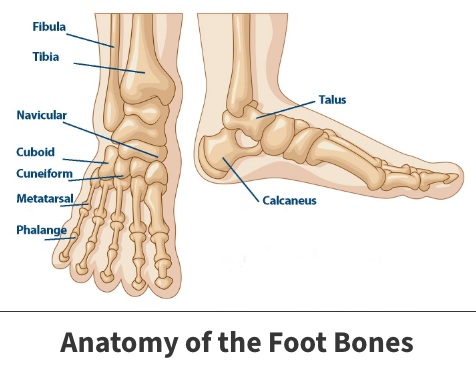Anatomy

Metatarsalgia, a forefoot injury, can occur in anyone, though athletes who take part in intense sports that involve running or jumping are at the highest risk. Metatarsalgia occurs when there is strong or unusual pressure on the ball of the foot, creating pain and inflammation.
About
Metatarsalgia can be caused by injury during sport or physical activity. If there is an abnormal weight distribution or unusual movement, the foot is more susceptible. Metatarsalgia pain generally occurs over time rather than immediately, and can last several months with increasing severity.
Some medical conditions predispose individuals to metatarsalgia problems.
- A high arch
- Hammertoe deformity
- A short first metatarsal bone or long second metatarsal bone
Symptoms
Symptoms include irritation and inflammation of the ball of the foot and pain at the end of one or more of the metatarsal bones.
The factors that contribute to metatarsalgia can include:
- Tight toe muscles
- Weak toe muscles
- Hypermobile first foot bone (when joints move easily beyond the normal range expected for that particular joint)
- Tight Achilles tendon
- Loose or tight footwear
- High or unusual levels or physical activity
- Hammertoe deformity
- Excessive side-to-side movements when walking
Also, some medical conditions may predispose individuals to metatarsalgia problems. These can include:
- A high arch
- Hammertoe deformity
- A short first metatarsal bone or a long second metatarsal bone
Pain is usually aggravated when walking or running. Athletes who have inflammatory conditions such as bursitis often also have forefoot pain.

Diagnosis
Your Florida Orthopaedic Institute physician will evaluate your symptoms and examine your foot. From there, they will assist you in assessing which treatment options are best.
Various tests can assist in pinpointing places of inflammation and damage, and help identify conditions that could be causing metatarsalgia such as bursitis or Morton neuroma.
Your physician may also determine that an MRI scan (magnetic resonance imaging) is the best option to detect and diagnose any disorders or conditions that result from any biomechanical imbalance.
Treatment
Fortunately, metatarsalgia can be treated in most cases by rehabilitation and does not need any surgical intervention. Your physician will help you determine which course of treatment and rehabilitation practices are right for you.
Nonsurgical treatment
Icing the foot and applying a pressure bandage can help start the healing process. Your physician may also recommend not standing on the foot for a few days while it gets adjusted to the pressure bandage.
Rehabilitation can assist in getting back on your feet quicker by restoring the range of motion. Recreational therapy such as swimming can be a good alternative to normal weight-bearing sports. Supportive shoes should be worn and are also an effective treatment.
It is important to not disrupt the healing process by following your physician’s orders – stretching properly and not returning to physical activity until given the go-ahead to do so.
Surgical treatment
In extreme cases, surgery may be recommended to treat metatarsalgia. If there is severe pain and inflammation that does not subside, surgical realignment of the metatarsal bones may be required during metatarsalgia surgery. Your Florida Orthopaedic Institute physician will evaluate your treatment progress and discuss with you any additional surgical procedures that they feel are needed.

Learn everything you need to know about metatarsalgia in our downloadable guide.
Related specialties
- Achilles Calcific Tendinitis
- Achilles Tendon Rupture
- Achilles Tendonitis
- Ankle Fracture Surgery
- Ankle Fractures (Broken Ankle)
- Ankle Fusion Surgery
- Arthroscopic Articular Cartilage Repair
- Arthroscopy of the Ankle
- Bunions
- Charcot Joint
- Common Foot Fractures in Athletes
- Foot Stress Fractures
- Hallux Rigidus Surgery - Cheilectomy
- Hammer Toe
- High Ankle Sprain (Syndesmosis Ligament Injury)
- Intraarticular Calcaneal Fracture
- Lisfranc Injuries
- Mallet, Hammer & Claw Toes
- Neuromas (Foot)
- Plantar Fasciitis
- Sprained Ankle
- Total Ankle Replacement
- Turf Toe
